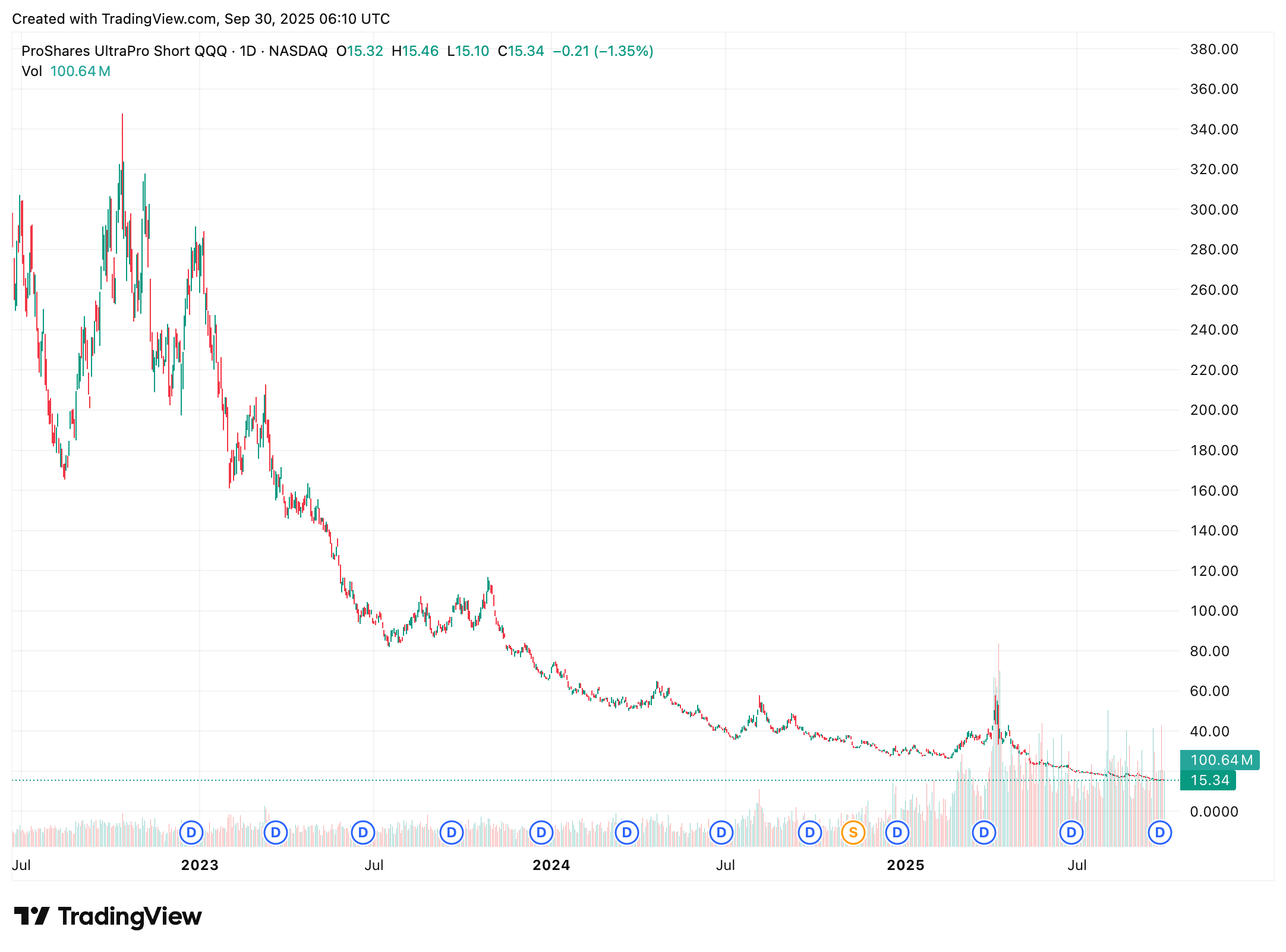Appearance
Government Shutdown: Is SQQQ Your Market Hedge?

Overview
SQQQ is a 3x inverse ETF designed to deliver approximately −3 times the DAILY return of the Nasdaq-100 (QQQ). It’s a short-term trading or hedging tool—not a buy-and-hold investment—because it resets daily and is subject to volatility decay. Use it when expecting near-term downside or for tactical hedging on tech-heavy risk.
Key takeaways
- Best for short-term trades or hedges during persistent downtrends in QQQ.
- Avoid in choppy, sideways markets—daily compounding can erode returns.
- Size positions by risk (stop distance), not by maximum leverage or “gut feel.”
- Rebalance frequently; SQQQ’s daily reset makes longer holds path-dependent.
What SQQQ is (and isn’t)
- Is: A −3x daily inverse vehicle on QQQ for tactical bearish exposure.
- Isn’t: A long-term short on tech. Holding through chop causes decay and fees.
| Day | NASDAQ Return (R_NASDAQ) | SQQQ Daily Return (R_SQQQ) | SQQQ Daily Return Factor (1 + R_SQQQ) | Compounded Return Factor (Cumulative) | Total Compounded Return |
|---|---|---|---|---|---|
| 1 | -2.00% | 0.06 | 1.06 | 1.06 | 0.06 |
| 2 | -1.00% | 0.03 | 1.03 | 1.0918 | 0.0918 |
| 3 | 1.50% | -0.045 | 0.955 | 1.042669 | 0.042669 |
When SQQQ tends to work best
- Persistent risk-off regimes: QQQ below 200-day MA, lower highs/lows.
- Rising real yields and strong USD pressuring high-duration tech.
- Earnings revisions rolling over for mega-cap tech.
- Widening credit spreads; rising VIX in backwardation.
- Nasdaq new lows exceeding new highs.
When to avoid or keep tiny
- Rangebound chop around major moving averages.
- Binary events with gap risk (earnings, CPI, FOMC).
- Strong risk-on rallies due to potential short squeezes.
Decision checklist
- Trend: QQQ below 200-day MA; 50-day MA sloping down; weak breadth.
- Momentum: MACD bearish cross; RSI < 50.
- Volatility & credit: VIX > 20 and rising; HY spreads widening.
- Macro: 10y real yields rising; DXY uptrend; negative earnings revisions.
- If 3–4 align bearishly, SQQQ has higher probability of success.
Entry and exit rules (example playbook)
- Timeframe: Use 1H for timing, Daily for regime analysis.
- Entry: On QQQ breakdown with bearish MACD and RSI < 50 or failed rally into 20/50-day MAs.
- Stop-loss: Place just beyond recent SQQQ swing or 1.5×ATR(14).
- Take profit: Scale at +1R, trail with 2×ATR, or exit on QQQ bullish reversal.
- Holding period: Days to a few weeks; reassess daily due to compounding and funding costs.
- Position sizing: Risk ≤ 0.5–1% of account; calculate shares by risk ÷ stop distance.
Example
- Account $25,000; risk 1% = $250.
- SQQQ price $20; ATR(14) ≈ $0.80.
- Stop = $18.80 (1.5×ATR below entry).
- Shares ≈ 208; notional ≈ $4,160.
Hedging a QQQ portfolio with SQQQ
- SQQQ targets −3x DAILY QQQ moves.
- For one-day hedge: buy ≈ 1/3 QQQ exposure.
- E.g., $90k in QQQ → buy ≈ $30k of SQQQ (rebalance frequently).
- Hedging drifts due to compounding; recheck sizing daily for tight hedges.
Scenario map for SQQQ use
| Scenario | Tactics |
|---|---|
| Bear trend (best) | Stagger entries on failed bounces; trail stops. |
| Sharp correction | Buy on break of support; take profits on panic spikes; don’t overstay. |
| Chop (worst) | Avoid or use defined-risk options instead of shares. |
Alternatives to consider
| Ticker | Exposure | Use case | Notes |
|---|---|---|---|
| PSQ | −1x QQQ | Conservative hedge | Less decay, simpler sizing |
| QID | −2x QQQ | Moderate leverage | Middle ground |
| SQQQ | −3x QQQ | Aggressive, short-term | Highest decay risk, tight risk rules |
| QQQ puts | Defined risk | Event hedges | Requires liquidity and expiry management |
| Short QQQ | Direct short | No daily reset | Unlimited loss risk |
Safer bearish strategies
- Raise cash and stablecoins to preserve dry powder.
- Use non-leveraged inverse ETFs (like PSQ) for smoother hedges.
- DCA into quality assets during downturns instead of gambling on inverse ETFs.
Costs and risks to respect
- Daily reset and path dependency cause decay in sideways markets.
- Higher expense ratios and trading spreads than plain ETFs.
- Overnight gap risk from earnings or macro data.
- Frequent trades can lead to short-term capital gains tax.
Common mistakes
- Treating SQQQ as a long-term investment.
- Oversizing based on cheap share prices.
- Premature entry without confirmation.
- Ignoring broader market context (breadth, credit, volatility).
- Forgetting stop-loss and bracket orders (reduce-only, OCO).
Quick copy-paste template
- Thesis: QQQ below 200-day MA; RSI < 50; MACD down; rising VIX.
- Entry: Buy SQQQ on QQQ breakdown or failed rally into 20/50-day MAs.
- Risk: 0.75%; stop 1.5×ATR.
- Take profit: +1R scale; trail remainder to +2–3R or exit on QQQ RSI > 50.
- Review daily; flatten if QQQ reclaims 50-day MA with momentum.
FAQ
- Can I hold SQQQ for months? Technically yes, but decay and compounding erode returns unless QQQ trends down persistently.
- Why not short QQQ? Shorting needs margin, has unlimited loss risk; inverse ETFs cap losses but have decay.
- Is timing everything? Yes—combine technical confirmation with macro context for best results.